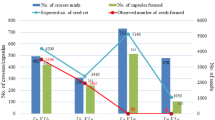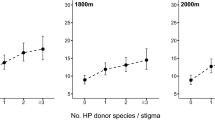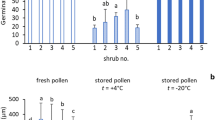Abstract
Incipient incompatibility barriers often are the incidental by-products of divergent evolution. Accordingly, one expects pollen from outside of a population to be less successful than pollen from the same population or to be similar to it. Contrary to expectation, we find that in the predominantly self-fertilising Phlox cuspidata, alien pollen typically is at an advantage. We crossed greenhouse grown plants with pollen from their own populations and pollen from other populations, and determined the germination percentage of pollen grains on stigmas. Alien pollen had higher germination rates in 13 of the 14 populations, and for 10 populations the differences were statistically significant. Over all populations, the mean germination was 27·1 per cent for alien pollen versus 20·8 per cent for local pollen, a statistically significant difference. There was no relationship between the germination of alien pollen and the distance between pollen source and recipient.
Similar content being viewed by others
Article PDF
References
Banyard, B J, and James, S H. (1979). Biosystematic studies in the Stylidium crassifolium species complex (Stylidiaceae). Aust J Bot, 27, 27–37.
Bookman, S S. 1984. Evidence for selective fruit production in Asclepias. Evolution, 38, 72–86.
Brown, A D H. 1979. Enzyme polymorphism in plant populations. Theor Pop Biol, 15, 1–42.
Coates, D J. 1981. Chromosome, morphometric and breeding system studies in the Stylidium caricifolium species complex (Stylidiaceae). Aust J Bot, 29, 397–417.
Ehrman, E. 1966. Mating success and genotype frequency in Drosophila. Anim Behav, 14, 332–339.
Ehrman, L. 1967. Further studies on genotype frequency and mating success in Drosophila. Amer Natur, 101, 415–425.
Ehrman, L, and Petit, C. 1968. Genotype frequency and mating success in the willistoni species group of Drosophila. Evol, 22, 649–658.
Gottlieb, E D. 1977. Electrophoretic evidence and plant systematics. Ann Missouri Bot Gard, 64, 161–180.
James, S H. 1979. Chromosome numbers and genetic systems in the trigger plants of Western Australia (Stylidium: Stylidiaceae). Aust J Bot, 27, 17–25.
Kephart, S R. 1981. Breeding systems in Asclepias incarnata L., A. syriaca L., and A. verticillata L. Amer J Bot, 68, 226–232.
Levin, D A. 1976. Consequences of long-term artificial selection, inbreeding and isolation in Phlox. The evolution of cross-incompatibility. Evol, 30, 335–344.
Levin, D A. 1978. The Origin Of Isolating Mechanisms In Flowering Plants. Evol Biol, 11, 185–315.
Levin, D A. 1978. Genetic Variation In Annual Phlox: Self-Compatible Versus Self-Incompatible Species. Evol, 32, 245–263.
Levin, D A. 1981. Dispersal versus gene flow in plants. Ann Missouri Bot, Gard, 68, 233–253.
Waser, N M, and Price, M V. 1983. Optimal and actual outcrossing in plants, and the nature of plant-pollinator interaction, pp. 341–359. In C. E. Jones and R. J. Little (eds.), Handbook of Experimental Pollination Biology. Van Nostrand, New York.
Wright, S. 1964. The distribution of self-incompatibility alleles in populations. Evol, 18, 609–619.
Yokoyama, S, and Hetherington, L E. 1982. The expected number of self-incompatibility alleles in finite plant populations. Heredity, 48, 299–303.
Yokoyama, S, and Nei, M. 1979. Population dynamics of sex-determining alleles in honeybees and self-incompatibility alleles in plants. Genetics, 91, 609–626.
Author information
Authors and Affiliations
Rights and permissions
About this article
Cite this article
Levin, D., Clay, K. Extraneous pollen advantage in Phlox cuspidata. Heredity 54, 145–148 (1985). https://doi.org/10.1038/hdy.1985.19
Received:
Issue date:
DOI: https://doi.org/10.1038/hdy.1985.19



